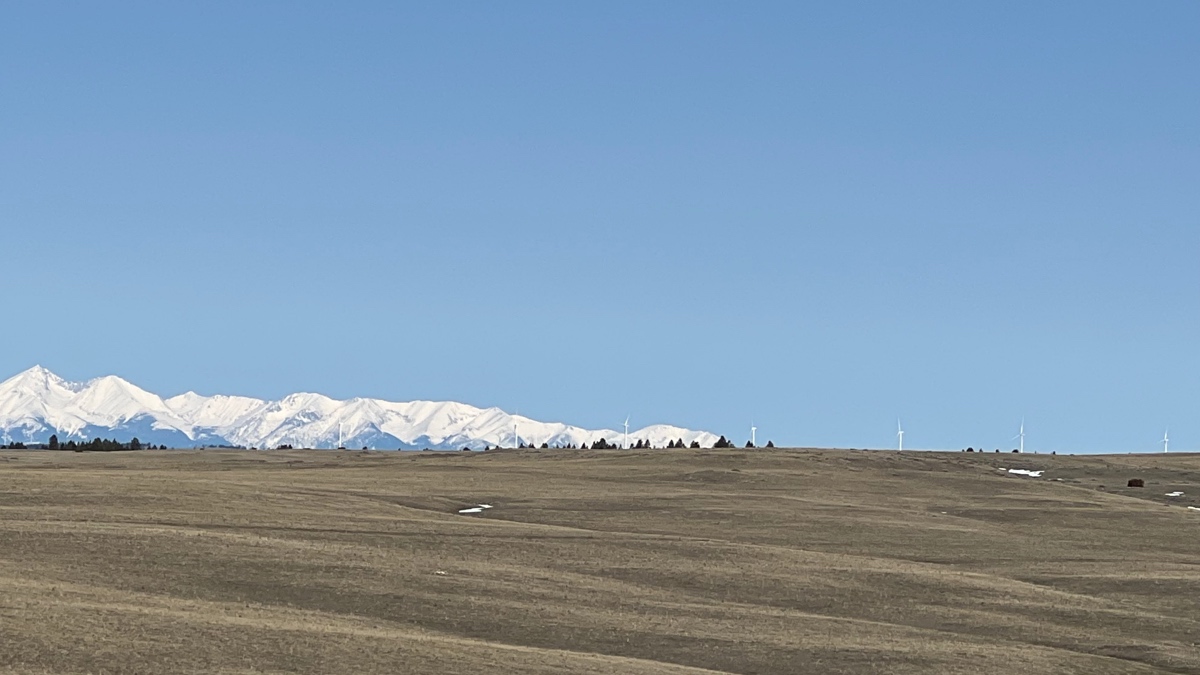Construction will start this summer on new-to-Montana concept that developers say addresses inconsistency of wind power.
By Linda Halstead-Acharya MONTANA FREE PRESS
RAPELJE — The homes are few and far between on the high plains that sweep between Rapelje and Reed Point. Though remote, the area is poised to mark a first in Montana: a place where the power of wind will be stored.
Last month, Stillwater County approved two phases of a wind farm that will incorporate large batteries for storing energy. The new-to-Montana concept addresses what skeptics fault about wind power: that it’s inconsistent and unreliable.
The batteries offer a way to offset the vagaries of wind by storing excess energy when demand is low and tapping that energy when demand peaks.
The permit was the last box to be checked for Beaver Creek Wind Farms II and III. Each project is rated at 80 megawatts of power slated for NorthWestern Energy’s system via transmission lines roughly four miles from the proposed farms. Caithness Beaver Creek, the New York company developing the wind farms, estimates the two phases could power nearly 115,000 homes.
While wind farms are not new to Montana, the incorporation of batteries is.
Derrel Grant, senior vice president of development for Caithness Beaver Creek, refers to the model as a hybrid wind and storage facility.
“It’s a unique utilization of the technologies,” he said. “It might be new to Montana, but it’s not new to the industry.”
In some places, developers have lassoed the power of the wind using water as a “battery.” When wind energy exceeds demand, water is pumped into an elevated reservoir. When demand outstrips production, the water is released, flowing down and creating hydro energy.
The Beaver Creek projects, however, will rely on lithium-ion batteries that will “firm up” the wind power by smoothing out the highs and lows of the wind so the output will be more consistent. Grant describes the batteries as somewhat like those in an electric car, only on a much larger scale. They will be stored in containers that occupy about three acres of the wind farm. According to Caithness, the batteries will provide approximately three-and-a-half to four hours of storage. That means if the batteries are full and the wind stops blowing, they will produce 20 megawatts of power for that duration.
“In the power industry, we want power to be steady during discrete periods of time,” Grant said. “The batteries can smooth out that power to put into the grid.”
The Stillwater County commissioners are impressed by the technology but waiting to see how the project pans out. Commission Chairman Ty Hamilton was initially concerned the massive batteries might pose a fire risk, but he noted that Caithness has incorporated sprinklers into its design.
“In the power industry, we want power to be steady during discrete periods of time. The batteries can smooth out that power to put into the grid.”
DERREL GRANT, SENIOR VICE PRESIDENT OF DEVELOPMENT FOR CAITHNESS BEAVER CREEK
In general, the commissioners had less to say about the novel concept than about general issues associated with wind farms and their construction. The Beaver Creek projects won’t be the county’s first rodeo, having recently experienced the construction of Pattern Energy’s Stillwater Wind, an operating wind farm adjacent to the proposed Beaver Creek projects.
Road impacts, taxes, economic diversification and public opinion topped the list of their considerations, along with a few lessons learned from experience — all of which were the focus of conditions listed in the county’s permit. The commissioners heard few comments regarding the visual impact of the proposed wind farm, but heard plenty when it came to better communication from the company to local residents.
“We’re talking a lot of traffic on these roads and a lot of large loads,” Hamilton said. “Those roads are used for agricultural purposes, so we wanted to make sure the landowners are alerted when those loads are expected. That was a big ask of the public.”
There are both winners and losers among area landowners. The Eder place is one of the former.
The late Delbert Eder had long championed a wind farm in the area but didn’t live to see it. Pattern Energy’s farm is just across the road from the family place, and now Beaver Creek II and III will be constructed on their land, which is currently being used for cattle grazing and hay production.
Eder’s son Loren, who lives in Columbus, said his father envisioned the wind farm not just as a way to generate electricity, but also as an additional resource to help pay the bills. “He saw it like raising alternative crops or improving genetics,” Loren Eder said. “It’s whatever you can do to make a better product.” Eder would like to see the energy “stay local,” but admits he has little say in that decision.
“Undoubtedly, in the [construction] process it will interfere with grazing, and it will take some ground out of production,” he said. “It’s like building a house. The process is a headache, but, when all is said and done, it’s well worth the effort.”
Bob VanOosten’s ranch, located several miles from the Eder’s, is not part of the wind farm’s footprint. He won’t benefit from lease payments or royalties, but he will deal with construction related issues.
“The existence of a wind farm there is irrelevant,” VanOosten said. “It won’t give us cheaper electricity. But we get to enjoy the impacts.”
“He saw it like raising alternative crops or improving genetics. It’s whatever you can do to make a better product.”
LOREN EDER
During construction of Pattern Energy’s project, VanOosten counted 100 loaded semis and at least 100 other vehicles passing by on a daily basis — using a road that had previously been traveled only lightly by locals. The road took a beating and dust often made driving conditions dangerous. VanOosten himself was involved in a collision when a subcontractor took more than his share of the road.
VanOosten does not oppose the projects, but he hopes the construction will be less onerous this time.
As for the battery aspect of the upcoming wind farms, he admitted curiosity.
“It’s a cool concept,” he said. “I’ll be begging for a tour to see the battery complex when it’s done.”
The county’s permit does not address bird fatalities, a problem often associated with wind farms. Grant said Caithness conducted detailed surveys that determined the project’s impact on birds would be insignificant.
Caithness estimates Beaver Creek II and III will employ 175 workers during the year-long construction phase and 16 to 20 permanent, on-site workers after completion. According to the company, the 48 wind turbines of each phase will combine to generate 4.5 percent of the total renewable energy currently produced in Montana.
The price tag for constructing the two projects is estimated at $253 million. The wind farms are projected to bring in $48 million in property taxes over 25 years and qualify for tax rebates through the first 10 years. Somewhat offsetting the rebates, Caithness has agreed to pay Stillwater County roughly $1.265 million in impact fees — a figure that can vary depending on the final cost of the project — for each of the first three years.
“This starts to diversify Stillwater County’s tax base to where there’s not so much reliance on Stillwater [Mining Company],” said former Stillwater County Commissioner Mark Crago, who was instrumental in bringing the projects to the county.
Ultimately, two additional phases — Beaver Creek I and IV — are planned. With all four phases across 20,000 acres, the wind farms will generate enough energy to power roughly 227,000 homes.
Caithness plans to start construction this summer. Turbines and storage facilities will be installed next spring, and — barring unforeseen hold-ups — the wind farm is scheduled to be in service by the end of 2023.













